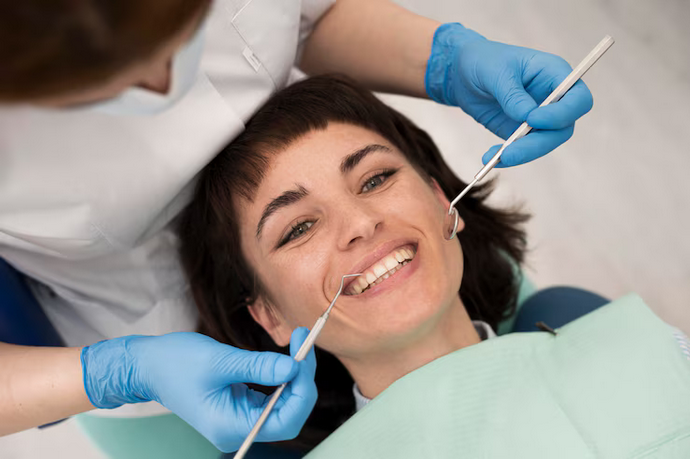Introduction
Cosmetic dentistry is a field dedicated to enhancing the aesthetics of smiles through various dental procedures. It merges artistry with dental science to create beautiful, natural-looking smiles that boost confidence and improve overall oral health. From teeth whitening to porcelain veneers, cosmetic dentistry offers a range of solutions to address imperfections and transform smiles. This article delves into the fascinating world of cosmetic dentistry, exploring its principles, popular procedures, advancements, and impact on individuals' lives.
Understanding Cosmetic
Dentistry Cosmetic dentistry is a specialized branch of dentistry focused on improving the appearance of teeth, gums, and smiles. Unlike traditional dentistry, which primarily deals with oral hygiene and health, cosmetic dentistry aims to enhance aesthetics. It addresses issues such as tooth discoloration, misalignment, gaps, chips, and disproportionate gum-to-tooth ratio. The ultimate goal is to create harmonious, attractive smiles that complement facial features and instill confidence in patients.
Principles of Cosmetic Dentistry
Several key principles guide cosmetic dentistry procedures:
- Aesthetics: The primary focus of cosmetic dentistry is to achieve natural-looking results that enhance facial aesthetics. Dentists consider factors such as tooth shape, size, color, symmetry, and proportion to create balanced and appealing smiles.
- Functionality: While aesthetics are paramount, cosmetic dentistry also prioritizes functional aspects. Procedures should improve oral function, including biting, chewing, and speech, without compromising dental health.
- Preservation: Whenever possible, cosmetic dentistry emphasizes preserving natural tooth structure. Minimally invasive techniques are preferred to maintain tooth integrity and longevity.
- Customization: Every smile is unique, and cosmetic dental treatments should be tailored to individual needs and preferences. Dentists collaborate closely with patients to understand their goals and design personalized treatment plans.
Popular Cosmetic Dentistry
Procedures Cosmetic dentistry offers a wide range of procedures to address diverse aesthetic concerns. Some of the most popular treatments include:
- Teeth Whitening: Also known as bleaching, teeth whitening is a non-invasive procedure that lightens the color of natural teeth. It effectively removes stains caused by aging, diet, smoking, and certain medications, restoring a brighter, more youthful appearance to the smile.
- Porcelain Veneers: Porcelain veneers are thin, custom-made shells that cover the front surface of teeth to improve their appearance. They can correct issues such as discoloration, chips, cracks, gaps, and minor misalignment, providing a durable and natural-looking solution.
- Dental Implants: Dental implants are titanium posts surgically placed into the jawbone to replace missing teeth. They serve as sturdy anchors for dental restorations such as crowns, bridges, or dentures, restoring both function and aesthetics to the smile.
- Composite Bonding: Composite bonding involves the application of tooth-colored resin material to repair chipped, cracked, or decayed teeth. It can also be used to reshape misshapen teeth or close small gaps, offering a quick and cost-effective cosmetic enhancement.
- Invisalign®: Invisalign® is a discreet orthodontic treatment that uses clear aligners to gradually straighten misaligned teeth. It offers a more comfortable and aesthetically pleasing alternative to traditional braces, allowing patients to achieve a straighter smile without metal wires or brackets.
Advancements in Cosmetic Dentistry
Cosmetic dentistry is constantly evolving, driven by technological advancements, innovative materials, and refined techniques. Some notable advancements include:
- Digital Smile Design (DSD): Digital Smile Design utilizes computer technology and 3D imaging to plan and preview cosmetic dental treatments. It allows dentists to visualize the desired outcomes and communicate effectively with patients, ensuring precise results.
- Laser Dentistry: Laser technology has revolutionized various aspects of cosmetic dentistry, offering minimally invasive solutions for procedures such as gum contouring, teeth whitening, and tissue sculpting. Lasers provide greater precision, reduced discomfort, and faster healing times compared to traditional methods.
- CAD/CAM Technology: Computer-Aided Design/Computer-Aided Manufacturing (CAD/CAM) technology enables the fabrication of custom dental restorations with unparalleled accuracy and efficiency. It allows for the creation of precise crowns, veneers, and bridges in a single visit, streamlining the treatment process for patients.
- Biomimetic Dentistry: Biomimetic dentistry mimics the natural structure and function of teeth to achieve optimal aesthetic and functional outcomes. By preserving as much natural tooth structure as possible and using bio-compatible materials, biomimetic approaches promote long-term oral health and stability.
Impact of Cosmetic Dentistry
The impact of cosmetic dentistry extends beyond mere aesthetics, profoundly influencing individuals' self-esteem, social interactions, and overall well-being. A confident smile can enhance professional success, improve interpersonal relationships, and elevate quality of life. By addressing dental imperfections and restoring smiles, cosmetic dentistry empowers patients to feel more confident, attractive, and self-assured in various aspects of their lives.
Conclusion
Cosmetic dentist combines artistry and science to create beautiful, natural-looking smiles that enhance facial aesthetics and boost confidence. Guided by principles of aesthetics, functionality, preservation, and customization, cosmetic dentistry offers a range of procedures to address diverse aesthetic concerns. From teeth whitening to porcelain veneers and dental implants, advancements in technology and techniques continue to expand treatment options and improve outcomes. The transformative impact of cosmetic dentistry goes beyond physical appearance, enriching lives and instilling confidence in individuals' smiles. As the field continues to evolve, it will undoubtedly shape the future of dental care, helping people achieve healthier, happier smiles for years to come.





Comments